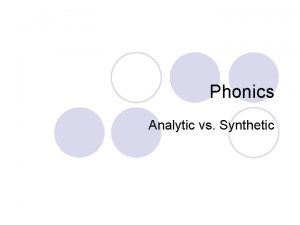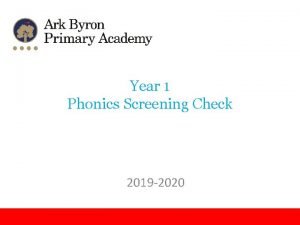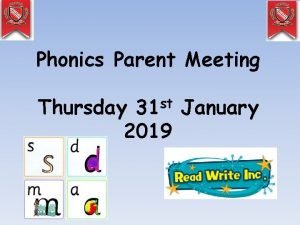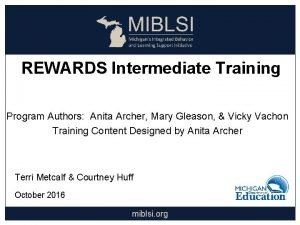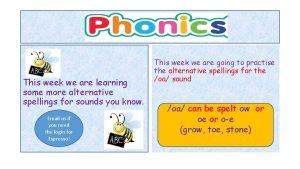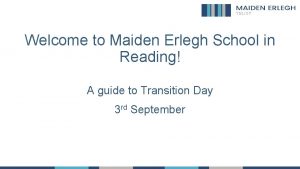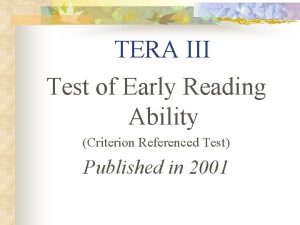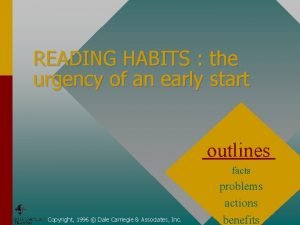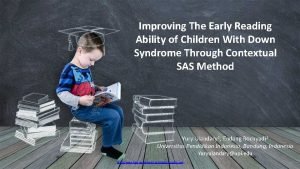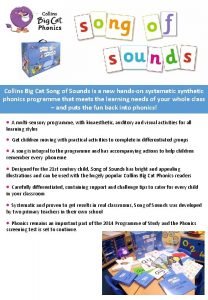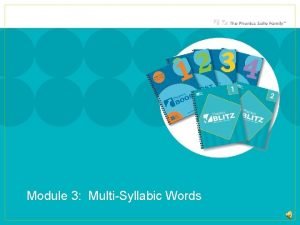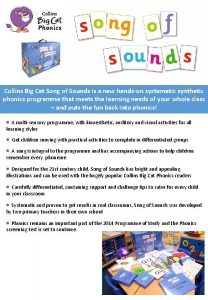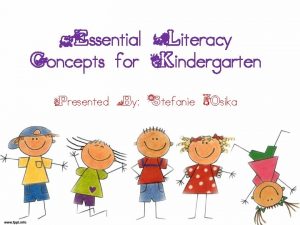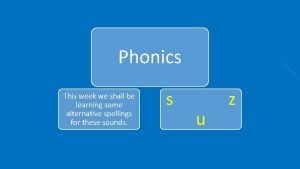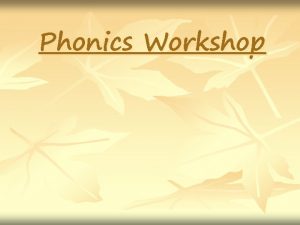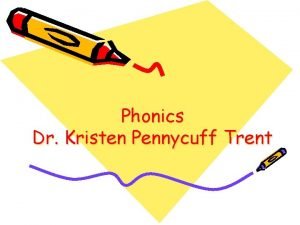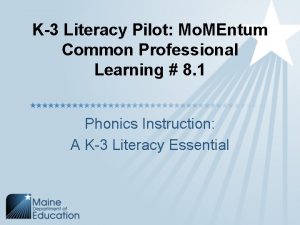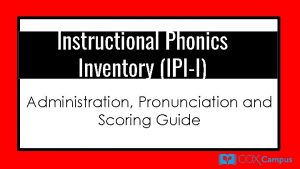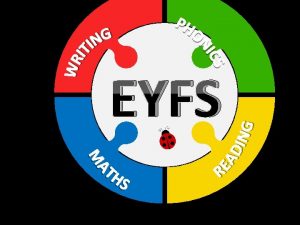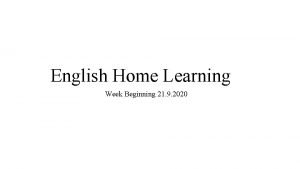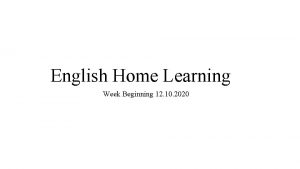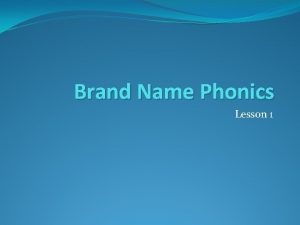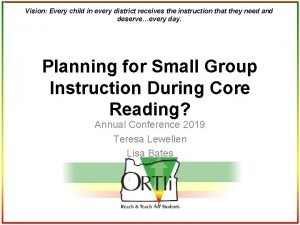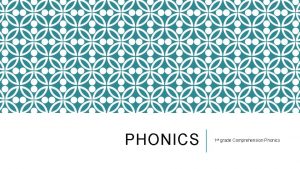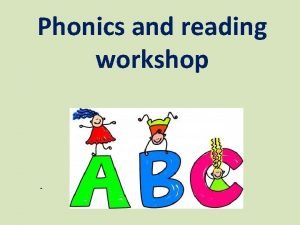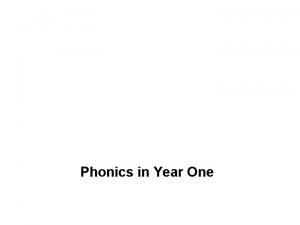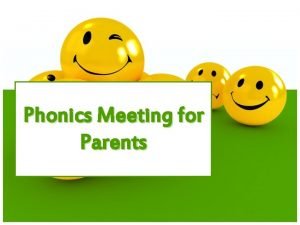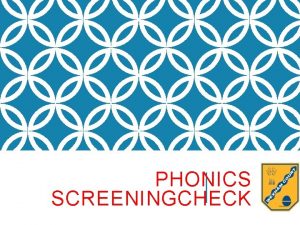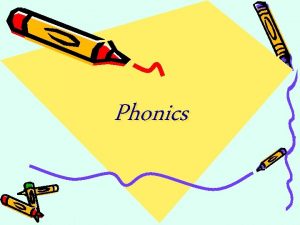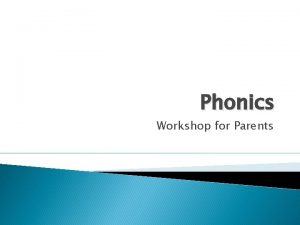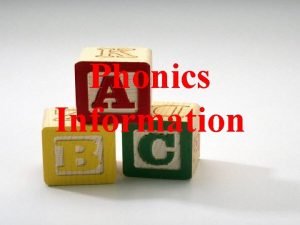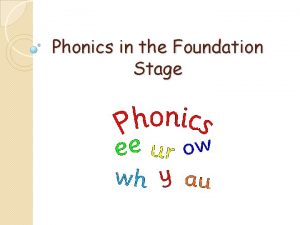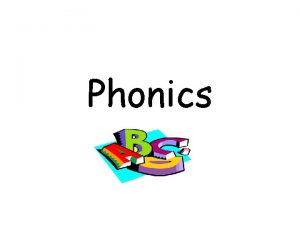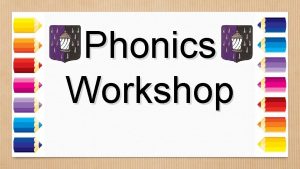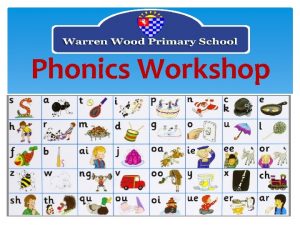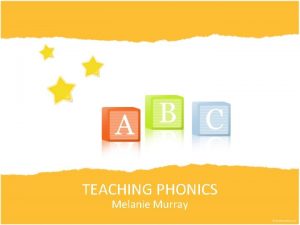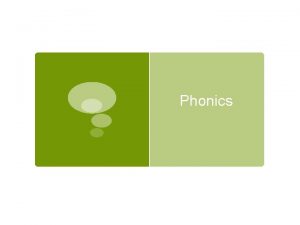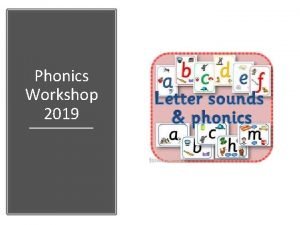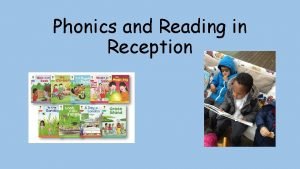Phonics and Early Reading 2019 Phonics and Early



































- Slides: 35

Phonics and Early Reading 2019

Phonics and Early reading Being able to read is the most important skill children will learn during their early schooling and has farreaching implications for lifelong confidence and well-being.

Successful readers and writers have lots of early opportunities to: • Talk and Listen. • Share books and have stories read to them. • Play listening games. • Sing songs and rhymes. All these things will help to build up connections in the brain, an enjoyment of language and confidence to try things out.

Since 2007 phonics has been the main way that we teach early reading.

What is phonics and how is it taught? • Knowledge of the alphabetic code. • The skills of segmenting and blending. • Children have a daily 15 -20 minute phonics session. • Follow the Letters and Sounds Scheme introduced by the DFE in 2007.

Some Definitions A Phoneme This is the smallest unit of sound in a word. How many phonemes can you hear in cat?

A grapheme These are the letters that represent the phoneme. The grapheme could be 1 letter, 2 letters or more! eg c ai igh Children need to practise recognising the grapheme and saying the phoneme that it represents.

A phoneme you hear A grapheme you see A word always has the same number of phonemes and graphemes!

More Definitions • DIGRAPHS – 2 letters that make 1 sound ll ss zz oa ai • TRIGRAPHS – 3 letters that make 1 sound igh ear air

BLENDING • Recognising the letter sounds in a written word, for example c-u-p and merging or ‘blending’ them in the order in which they are written to pronounce the word ‘cup’.

SEGMENTING • ‘Chopping Up’ the word to spell it out. • The opposite of blending. • Use your ‘phoneme fingers’.

Segment and Blend words… • drep • blom • gris Nonsense games like this help to build up skills – and are fun!

Example of segmenting • shelf = sh – e – l – f • dress = d - r - e – ss = 4 phonemes • sprint = s – p – r – i – n – t = 6 phonemes • string = s – t – r – i – ng = 5 phonemes

Letters and Sounds • A highly structured programme with 6 progressive phases. • Children are taught: The full range of common letter/ sound correspondences. To hear separate sounds within words. • To blend sounds together.

Phase 1 (Nursery) * Showing an awareness of rhyme and alliteration. * Hearing sounds in the environment. * Exploring and experimenting with sounds and words. * Discriminating speech sounds in words. * Beginning to orally blend and segment phonemes.

Phase 2 (Reception ) • Using common consonants and vowels. • Understanding that words are constructed from phonemes and that phonemes are represented by graphemes. • Blending for reading and segmenting for spelling simple cvc words.

Letter sets (phase 2 ) Set 1 Set 2 Set 3 Set 4 Set 5 - s, a, t, p, i, n, m, d, g, o, c, k, ck, e, u, r, h, b, f, ff, l, ll, ss,

Phase 3 (Reception ) Knowing one grapheme for each of the 44 phonemes. There are 44 phonemes in the English language!

Letter Progression: Set 6 - j, v, w, x Set 7 - y, z, zz, qu Consonant digraphs: ch, sh, th, ng. Vowel digraphs and trigraphs: ear, air, ure, er, ar, or, ur, ow, oi, ai, ee, igh, oa, oo

Phase 4 ( Reception/Year 1) • Segmenting adjacent consonants in words and applying this in spelling. Eg past, step, spend , train. • Blending adjacent consonants in words and applying this skill when reading unfamiliar texts.

Phase 5 (throughout Year 1) • Reading phonetically decodable twosyllable and three-syllable words eg dolphin, yesterday. • Alternative ways of pronouncing the graphemes they have already learnt eg bread, peach, frown, throw. • Alternative ways of spelling phonemes eg train, stay, cake, eight, acorn high, try, spike, find, tie.

Phase 6 Year 2 • Recognising phonic irregularities and becoming more secure with less common grapheme – phoneme correspondences. • Applying phonic skills and knowledge to recognise and spell an increasing number of complex words. • Introducing and teaching the past tense. • Investigating and learning how to add suffixes. • Spelling long words. • Finding and learning the difficult bits in words.

In addition to this, each week the children learn to read and write ‘tricky’ words (those that are not phonetically decodable) eg was, said. As their phonic knowledge grows some words that were ‘tricky’ become decodable, eg was, wash.

The children always work within the phase that is appropriate to their level of learning. They are assessed regularly and groupings are sorted accordingly. Therefore the suggested model of year group and corresponding phase, does not always go hand in hand with the year group that your child is actually in.

Key Points • Correct enunciation. • Correct vocabulary. • It helps if we can use the same vocabulary at home and school at home and at school.

The 44 phonemes /b/ /d/ /f/ /g/ /h/ /j/ /k/ /l/ /m/ /ng/ /p/ /r/ /s/ /t/ /v/ /w/ /y/ /z/ /th/ /ch/ /sh/ /zh/ /a/ /e/ /i/ /o/ /u/ /ae/ /ee/ /ie/ /oe/ /ue/ /oo/ /ar/ /ur/ /au/ /er/ /ow/ /oi/ /air/ /ear/ /ure/

Reading at Home • Find a quiet place, away from T. V. etc. • Little and often. • Look at the title, front cover. What could the book be about? Read the blurb on the back. • Talk about the illustrations. • Discuss the characters, what are they thinking / feeling? What might they do next? • What might happen at the end? • Encourage children to sound out words they don’t know. • Make a note in the reading diary.

Reading at Home • Read a wide variety of different types of books. • Read books by the same author. • Visit the local library. • Read stories to your child. • Let your child see you reading for pleasure.

Year 1 Phonics Screening • Every Year 1 child in the country will be taking the phonics screening check in the same week in June. • The aim of the check is to ensure that all children are able to read by the end of Year 2. • This ‘midpoint check’ will ensure that we have a clear understanding of what the children need to learn in Year 2.

What will the children be asked to do? • The check is very similar to tasks the children already complete during phonics lessons. • Children will be asked to ‘sound out’ a word and blend the sounds together, eg d-o-g - dog • The focus of the check is to see which sounds the children know and therefore the children will be asked to read made up ‘nonsense’ words.

Examples of Words

When will the screening check take place? • During the week 11 th June, so it is very important your child is in school during this week. • The check has been designed so that all children will be able to take part. It tests graphemes from phases 2 to 5

How will the check be carried out? • The children will complete the check one at a time in a quiet area of the school. • It will be administered by Mrs Hawkins. • The screening will only take 5 -10 mins for each child.

Now you have the knowledge…. • Play lots of sound and listening games with your child. • Read as much as possible to and with your child. • Encourage and praise – get them to have a ‘good guess’. • Ask your child’s teacher if you want to know more.

Useful websites • • • www. parentsintouch. co. uk www. bbc. co. uk/schools/parents www. jollylearning. co. uk/ www. focusonphonics. co. uk/ www. syntheticphonics. com www. starfall. com www. galacticphonics. com www. mrthorne. com www. nessy. com www. phonicsplay. com www. teachyourmonstertoread. com
 Example of analytic phonics
Example of analytic phonics While reading activities
While reading activities 2019 phonics screening check
2019 phonics screening check Phonics test 2019
Phonics test 2019 Rewards anita archer
Rewards anita archer Reading robot phonics play
Reading robot phonics play Early cpr and early defibrillation can: *
Early cpr and early defibrillation can: * Aims of teaching reading
Aims of teaching reading Types of reading skills in communication
Types of reading skills in communication Real definition of extensive reading
Real definition of extensive reading Extensive reading
Extensive reading Intensive reading and extensive reading
Intensive reading and extensive reading Maiden early school reading
Maiden early school reading Tera-3
Tera-3 Why was wudi called the martial emperor?
Why was wudi called the martial emperor? Reading early start
Reading early start Test of early reading ability
Test of early reading ability Round robin reading vs popcorn reading
Round robin reading vs popcorn reading Edb net
Edb net Process of discovery in critical reading
Process of discovery in critical reading Cat song
Cat song Phonics blitz online
Phonics blitz online Collins big cat phonics for letters and sounds download
Collins big cat phonics for letters and sounds download Fountas and pinnell phonics kindergarten
Fountas and pinnell phonics kindergarten Phonics play obb and bob
Phonics play obb and bob Rose report phonics
Rose report phonics Analytic phonics
Analytic phonics Blending lines phonics
Blending lines phonics Phonics inventory assessment
Phonics inventory assessment Jolly phonics p
Jolly phonics p Jolly phonics d
Jolly phonics d Jolly phonics b
Jolly phonics b Explicit phonics instruction
Explicit phonics instruction Words that rhyme with eraser
Words that rhyme with eraser Ecri phonics
Ecri phonics The phonics dance
The phonics dance
